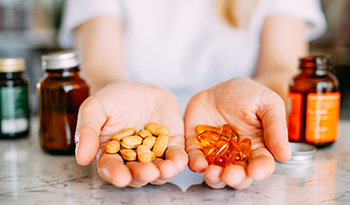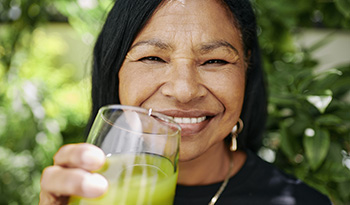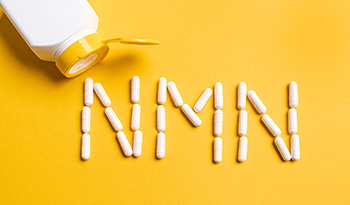Tension Headaches: Causes, Symptoms, Helpful Supplements, and More

What Is a Tension Headache?
Tension headaches, also known as tension-type headaches (TTH), are the most common primary headache disorder. And while they won't kill you, TTH can significantly impact your ability to work and overall quality of life. To complicate things, TTH and migraines can be confused with each other—or happen simultaneously.
While the research on nutritional supplement interventions for TTH is sparse (at best), this article takes a deep dive into tension headaches and examines the current research on how to manage them naturally.
Are Tension Headaches and Migraines Similar?
Yes and no. Migraines and tension-type headaches are both pervasive primary headache disorders and share some qualities that can make their specific diagnosis tricky.
Further, many folks can be "lucky enough" (sarcasm intended) to experience both migraines and tension headaches. Since we don't have any imaging methods or blood biomarkers to differentiate migraines from tension headaches, we must look closely at what folks are experiencing.
Tension Headaches
Tension-type headaches (TTH) are the most common headache disorder, with 30% to 70% of people experiencing TTHs at some point. TTH is relatively egalitarian, with men and women experiencing TTH at similar rates.
Patients often describe the feeling of a tension headache as a mild-to-moderate "band around the head." That band feels like a dull ache, pressure, or squeezing on both sides of the head (bilateral). Usually, TTH only lasts between 30 minutes to 24 hours but may last up to seven days.
TTH is not made worse by regular activities, doesn't typically have light/sound sensitivity, and nausea may present only mildly in chronic TTH patients.
Migraine Headaches
Migraine headaches are another common primary headache disorder, with around 15% of U.S. adults experiencing migraine. Unlike TTH, migraines are two to three times more common in women than men.
Migraine is more severe than TTH, lasting 4 to 72 hours with moderate-to-severe pulsatile pain that is one-sided (unilateral) in around 60% of patients. Migraine patients also commonly present with nausea, vomiting, and light and sound sensitivities. All of this can be made worse by everyday physical activities.
Common Causes of Tension Headaches
Much of the metabolic research on headaches investigates nutritional triggers and interventions for migraines. Less metabolic research focuses on tension headaches. However, the following are common triggers for both types of headaches:
- Caffeine (at doses above around 200 milligrams daily)
- Monosodium glutamate (though data on this is mixed)
- Mental or emotional stress
- Sleep disturbance
If you are dealing with chronic headaches of either type, it’s generally recommended to limit or explore your body’s response to caffeine, MSG, stress, and sleep disturbances. Keeping a "headache diary" can be very helpful for you and your provider.
Supplements for Tension Headache Prevention and Treatment
Peppermint Oil
Peppermint essential oil, mixed with a carrier oil, applied across the forehead and temples may reduce tension headaches as effectively as Tylenol.1 While not a classical "nutritional supplement," this simple medication alternative may have acute benefits during a tension headache.
Riboflavin
Riboflavin (vitamin B2) is responsible for the bright yellow color of your urine after taking a multivitamin. Just because it makes it to your urine does not render it useless—most pharmaceutical medications also make their way out through your urine and feces.
Studies examining riboflavin’s effect on headaches found taking between 25 to 400 milligrams per day had variable benefits in decreasing migraine frequency and may help relieve tension headaches.2,3 Riboflavin is often found in products or recommended by doctors in combination with nutrients like CoQ10 or magnesium.
Magnesium
Magnesium seems to be an "everywhere and everything" nutrient, like Vitamin D—probably because magnesium helps facilitate over 300 enzymes in the human body and plays a significant role in cardiovascular and neurological function.
Research shows that low magnesium intake is associated with migraines and that increased intake through diet or supplementation can reduce the frequency and severity of migraine headaches.4,5 Magnesium L-threonate may be the best supplemental form for increasing brain magnesium levels.
CoQ10
CoQ10 (formally, Coenzyme Q10) is a vitamin-like molecule used for energy production that acts as an antioxidant. Pretty cool, eh? Well, a dose of around 300 milligrams daily for at least three months may reduce migraine frequency and related nausea in folks suffering from migraine.6,7
Omega-3s
In the brain, 10% to 20% of all fat is omega-3 (EPA/DHA). Up to 97% of those omega-3 fatty acids are DHA, making DHA a crucial structural component and 100-fold more abundant than EPA in the central nervous system. Studies examining fish oil for migraine and headaches show it lowered inflammatory markers, while diets low in omega-3s are associated with more frequent morning headaches.8,9
Feverfew and Butterbur
Feverfew and butterbur are botanicals often used for headaches and migraine. Feverfew has more substantial evidence than butterbur, though you will often see these—and other nutrients discussed above—paired together. Feverfew is more effective as a prevention supplement for folks with more frequent headaches than those with less frequent ones.10,11
Supplements for Tension Headache Prevention
While the following supplements are not studied for or widely known to improve headache conditions, they may help manage stress, a common trigger and exacerbator of headaches.
L-theanine
L-theanine is a non-protein amino acid that promotes feelings of calm, pleasantness, and measurable increases in alpha waves. While not a sedative, L-theanine may help folks with stress and sleep disturbances.12
Phosphatidylserine
Phosphatidylserine is a phospholipid ("fat") found in high concentrations in the brain. Studies suggest supplementing with phosphatidylserine may have subtle effects on stress and mental resilience.13
Melatonin
Melatonin itself will not directly do anything to prevent or improve your headache symptoms. But taking between 1 to 3 milligrams may help improve sleep and reduce sleep disturbances that are known to trigger headaches.14
Tips for Managing Tension Headaches
Here are some additional tips for managing tension headaches:
- Avoid caffeine, alcohol, and processed foods.
- Get regular exercise and enough sleep.
- Practice relaxation techniques, such as yoga or meditation.
- Manage stress.
- If you have frequent or severe headaches, see your doctor.
Takeaway
Tension-type headaches (TTH) are a common primary headache disorder. TTH is typically less severe than migraine and is not associated with nausea, vomiting, or light and sound sensitivity.
Research on the effectiveness of nutritional supplements for TTH is limited. However, some studies have shown that riboflavin, magnesium, CoQ10, omega-3 fatty acids, feverfew, and butterbur may help reduce the frequency and severity of headaches.
Always consult your doctor before taking new supplements, as they can interact with your other medications. Keep a headache diary to track your symptoms and triggers so you can work with your doctor to develop a personalized treatment plan.
References:
- Göbel, H., Fresenius, J., Heinze, A., Dworschak, M., & Soyka, D. (1996). Effectiveness of Oleum menthae piperitae and paracetamol in therapy of headache of the tension type. Der Nervenarzt, 67(8), 672-681.
- Bruijn, J., Duivenvoorden, H., Passchier, J., Locher, H., Dijkstra, N., & Arts, W. F. (2010). Medium-dose riboflavin as a prophylactic agent in children with migraine: a preliminary placebo-controlled, randomised, double-blind, cross-over trial. Cephalalgia, 30(12), 1426-1434.
- Schoenen, J., Jacquy, J., & Lenaerts, M. (1998). Effectiveness of high‐dose riboflavin in migraine prophylaxis A randomized controlled trial. Neurology, 50(2), 466-470.
- Chiu, H. Y., Yeh, T. H., Yin-Cheng, H., & Pin-Yuan, C. (2016). Effects of intravenous and oral magnesium on reducing migraine: a meta-analysis of randomized controlled trials. Pain physician, 19(1), E97.
- Domitrz, I., & Cegielska, J. (2022). Magnesium as an Important Factor in the Pathogenesis and Treatment of Migraine—From Theory to Practice. Nutrients, 14(5), 1089.
- Parohan, M., Sarraf, P., Javanbakht, M. H., Foroushani, A. R., Ranji-Burachaloo, S., & Djalali, M. (2021). The synergistic effects of nano-curcumin and coenzyme Q10 supplementation in migraine prophylaxis: A randomized, placebo-controlled, double-blind trial. Nutritional neuroscience, 24(4), 317-326.
- Sándor PS, Di Clemente L, Coppola G, et al. Efficacy of coenzyme Q10 in migraine prophylaxis: a randomized controlled trial. Neurology. 2005;64(4):713-715. doi:10.1212/01.WNL.0000151975.03598.ED.
- Abdolahi, M., Tafakhori, A., Togha, M., Okhovat, A. A., Siassi, F., Eshraghian, M. R., ... & Djalali, M. (2017). The synergistic effects of ω-3 fatty acids and nano-curcumin supplementation on tumor necrosis factor (TNF)-α gene expression and serum level in migraine patients. Immunogenetics, 69, 371-378.
- Marchetti M, Gualtieri P, De Lorenzo A, Trombetta D, Smeriglio A, Ingegneri M, Cianci R, Frank G, Schifano G, Bigioni G, Di Renzo L. Dietary ω-3 intake for the treatment of morning headache: A randomized controlled trial. Front Neurol. 2022 Sep 20;13:987958.
- Pfaffenrath, V., Diener, H. C., Fischer, M., Friede, M., & Henneicke-von Zepelin, H. H. (2002). The efficacy and safety of Tanacetum parthenium (feverfew) in migraine prophylaxis—a double-blind, multicentre, randomized placebo-controlled dose-response study. Cephalalgia, 22(7), 523-532.
- Rajapakse, T., & Davenport, W. J. (2019). Phytomedicines in the treatment of migraine. CNS drugs, 33, 399-415.
- Yoto, A., Motoki, M., Murao, S., & Yokogoshi, H. (2012). Effects of L-theanine or caffeine intake on changes in blood pressure under physical and psychological stresses. Journal of physiological anthropology, 31(1), 1-9.
- Baumeister, J., Barthel, T., Geiss, K. R., & Weiss, M. (2008). Influence of phosphatidylserine on cognitive performance and cortical activity after induced stress. Nutritional neuroscience, 11(3), 103-110.
- Alstadhaug, K. B., Odeh, F., Salvesen, R., & Bekkelund, S. I. (2010). Prophylaxis of migraine with melatonin: a randomized controlled trial. Neurology, 75(17), 1527-1532.
DISCLAIMER:This Wellness Hub does not intend to provide diagnosis...













































































 Table of Contents
Table of Contents















